Rhamnolipids Market Size
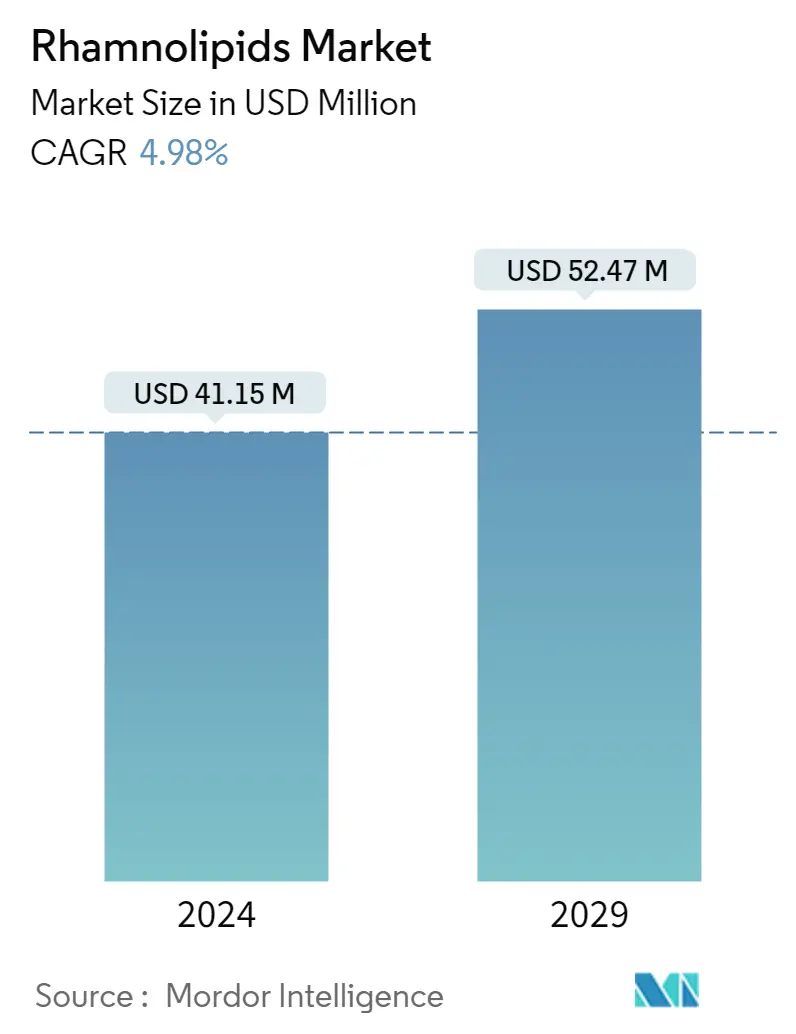
| Study Period | 2018 - 2028 |
| Market Size (2023) | USD 39.20 Million |
| Market Size (2028) | USD 49.98 Million |
| CAGR (2023 - 2028) | 4.98 % |
| Fastest Growing Market | Asia Pacific |
| Largest Market | Asia Pacific |
Major Players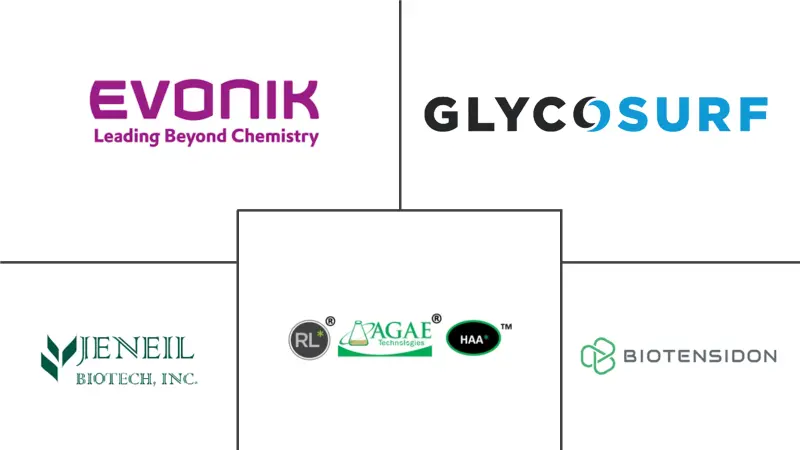
*Disclaimer: Major Players sorted in no particular order |
Need a report that reflects how COVID-19 has impacted this market and its growth?
Rhamnolipids Market Analysis
The Rhamnolipids Market size is expected to grow from USD 39.20 million in 2023 to USD 49.98 million by 2028, at a CAGR of 4.98% during the forecast period (2023-2028).
The COVID-19 outbreak resulted in a global lockdown, a breakdown in supply chains and manufacturing activities, and production halts, all of which had a detrimental effect on the market in 2020. However, things started to get better in 2021, which allowed the market to resume its upward trend for the remainder of the projected period.
- The major factor driving the market studied is the growing demand for rhamnolipids from surfactants. Moreover, the increasing demand for personal care products is also expected to fuel the market demand.
- On the flip side, the high manufacturing cost of rhamnolipids has hindered the growth of the market.
- The growing demand for bio-surfactants in the oil and gas sector is forecasted to offer various opportunities for the growth of the market over the forecast period.
- Asia-Pacific region represents the largest market and is also expected to be the fastest-growing market over the forecast period owing to the increasing consumption from countries such as China, India, and Japan.
Rhamnolipids Market Trends
Growing Demand of Rhamnolipids from Surfactants
- Rhamnolipid bio-surfactants have the property of getting dreaded easily in nature as compared to synthetic surfactants. They are believed to be a better alternative to synthetic surfactants due to their being skin-friendly, rinse-active, and very environmentally friendly.
- Rhamnolipid-based bio-detergents show comparable washing performance to synthetic detergents in terms of colorfastness to wash, color strength, and the color difference value.
- Rhamnolipid bio-surfactants are used in laundry detergents, floor cleaners, dishwashing liquids, and other cleaning products. Many companies have been introducing bio-surfactant cleaning and detergent products in the market.
- For instance, Evonik Industries AG announced the launch of sustainable rhamnolipid REWOFERM RL 100 biosurfactant meets demand from the cleaning solutions market for low-emission, low-impact cleaning products that enable a circular economy.
- According to IKW, the German Cosmetic, Toiletry, Perfumery and Detergent Association, the revenue from soaps and synthetic detergents in Germany was about EUR 462 million (~USD 486.8 million) in 2022.
- Moreover, according to Statcan, the Canadian Statistics Agency, the monthly manufacturer sales of soap and cleaning compounds in Canada in the first three months of 2023 accounted to be CAD 395.58 million (~USD 304 million), approximately 20% more than the previous year’s sales for the same period.
- According to the Brazilian Institute of Geography and Statistics, the revenue generated from the manufacturing of soaps and detergents in Brazil in 2022 is expected to be over USD 4.52 billion. The institution also anticipates revenues of roughly USD 4.56 billion in 2023.
- Hence, owing to the above-mentioned factors, the application of rhamnolipids from surfactant is likely to dominate during the forecast period.
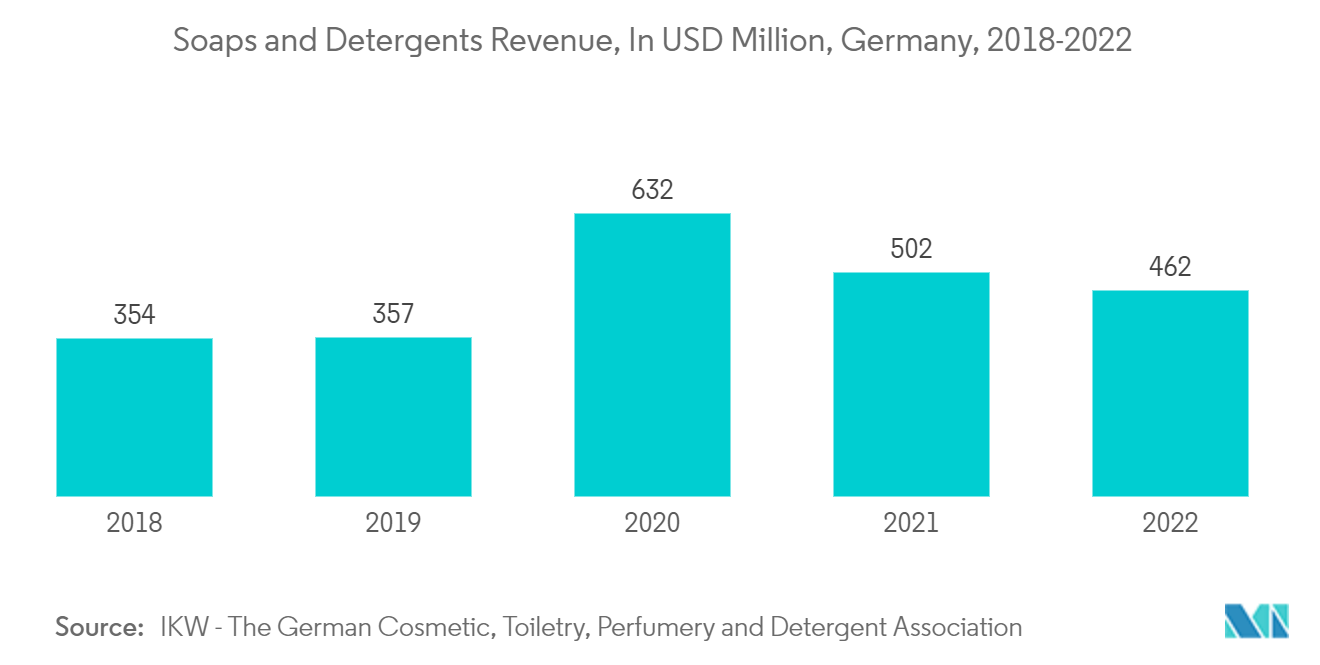
Asia-Pacific Region to Dominate the Market
- Currently, Asia-Pacific accounts for the highest share of surfactants, lubricants, and pharmaceuticals in the global market owing to the demand from the industries and end-use applications.
- According to the Department for Promotion of Industry and Internal Trade in India, the proposed investment value in the soaps, cosmetics, and toiletries sector in the country for year 2022 is around INR 2.26 billion (~USD 28.7 million).
- As of June 2022, the Indian Detergent market size was INR 12,000 crore (~USD 150 million). Due to the increasing urbanization rate in the country, there is an increasing demand for better-quality products. To meet these demands for quality washing powders, the top brands in India are innovating better-packaged products that come with many benefits in a single wash.
- China is also one of the major consumers of cosmetics. In 2022, the retail sales of cosmetics by wholesale and retail companies in China totaled about CNY 393.6 billion (~USD 57 billion). This though, indicated a slight decrease compared to the previous year which had a total retail sale of about CNY 402.6 billion (~USD 58.6 billion), as stated by the National Bureau of Statistics of China.
- Additionally, according to the Ministry of Economy, Trade and Industry in Japan, toilet and hand soap production in the country amounted to around 9.72 million units in the month of April 2023.
- Moreover, in the global pharmaceuticals sector, India is a prominent and expanding player. India is one of the world’s major suppliers of generic medicines, accounting for 20% of the global supply by volume. Indian drugs are exported to more than 200 countries in the world, with the United States being the key market. Furthermore, India’s generic drugs satisfy 40% of the generic drug demand of the United States and 30% of the United Kingdom. The domestic drug manufacturers consist of a chain of around 10,500 companies.’
- Hence, owing to the above-mentioned factors, Asia-Pacific is likely to dominate the rhamnolipids market during the forecast period.
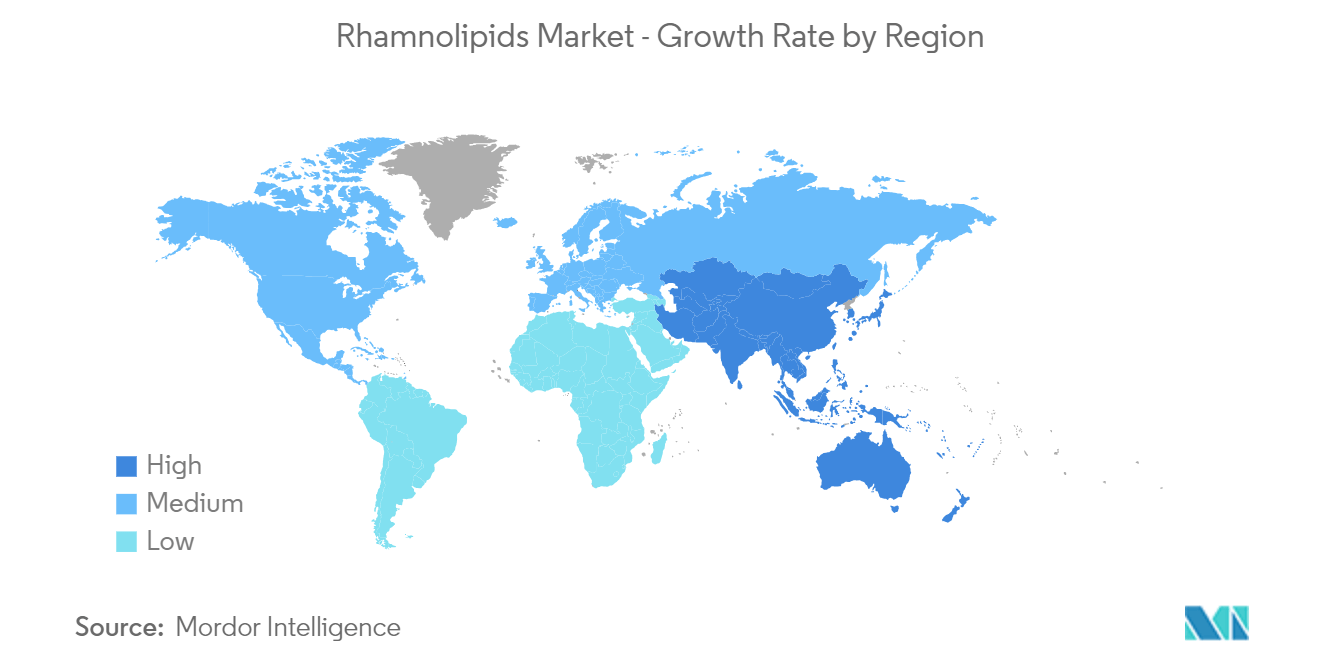
Rhamnolipids Industry Overview
The global rhamnolipids market is partially consolidated in nature with only few major players dominating the market. Some of the major companies are (not in any particular order) Evonik Industries AG, Jeneil, GlycoSurf, AGAE Technologies, LLC, and Biotensidon GmbH among others.
Rhamnolipids Market Leaders
Evonik Industries AG
Jeneil
AGAE Technologies, LLC
Biotensidon GmbH
Glycosurf
*Disclaimer: Major Players sorted in no particular order
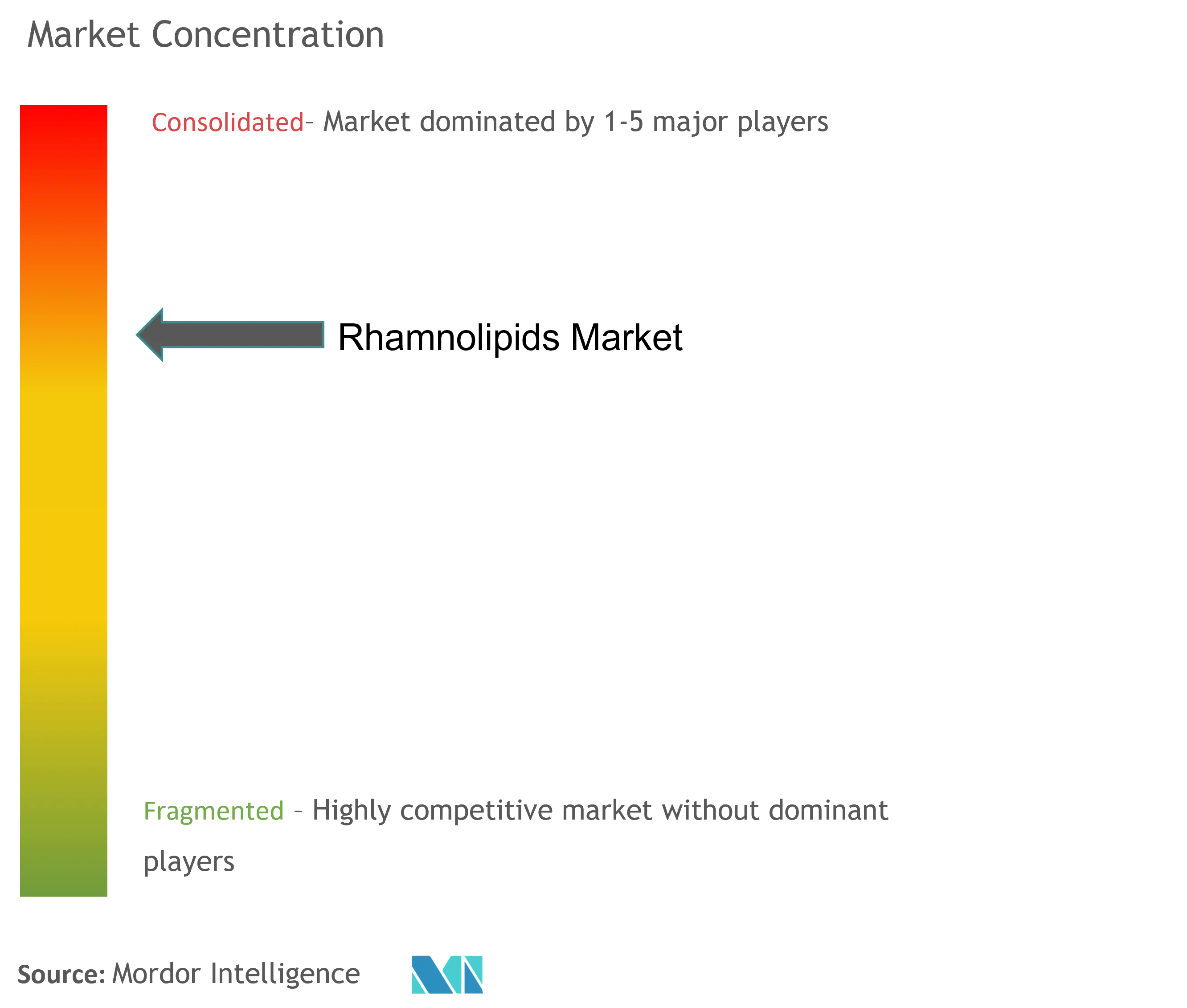
Rhamnolipids Market News
- In September 2022, AGAE Technologies, LLC announced the discovery of employing certain strains and mediums under optimized fermentation conditions to obtain record-high rhamnolipid yields at the lowest possible cost. When compared to traditionally optimized fermentation settings, the fermentation methods enhanced yields by approximately 200% while lowering production costs to about one-third of the conventionally optimized conditions.
- In June 2022, Evonik Industries AG announced the commencement of construction of the world's first commercial rhamnolipid manufacturing facility, which is projected to cost in the range of triple-digit millions of euros. This would position Evonik as a commercial pioneer of high-quality, sustainable biosurfactants as well as boost the location in Slovenská Lupca as a strategic biotechnology center.
Rhamnolipids Market Report - Table of Contents
1. INTRODUCTION
1.1 Study Assumptions
1.2 Scope of the Study
2. RESEARCH METHODOLOGY
3. EXECUTIVE SUMMARY
4. MARKET DYNAMICS
4.1 Drivers
4.1.1 Growing Demand of Rhamnolipids from Surfactants
4.1.2 Increasing Demand for Personal Care Products
4.1.3 Other Drivers
4.2 Restraints
4.2.1 High Manufacturing Cost of Rhamnolipids
4.2.2 Other restraints
4.3 Industry Value Chain Analysis
4.4 Porter's Five Forces Analysis
4.4.1 Threat of New Entrants
4.4.2 Bargaining Power of Buyers
4.4.3 Bargaining Power of Suppliers
4.4.4 Threat of Substitute Products
4.4.5 Degree of Competition
5. MARKET SEGMENTATION (Market Size in Volume)
5.1 Type
5.1.1 Mono-Rhamnolipids
5.1.2 Di-Rhamnolipids
5.2 Application
5.2.1 Surfactants
5.2.2 Lubricant
5.2.3 Agriculture
5.2.4 Food
5.2.5 Pharmaceutical
5.2.6 Other Applications
5.3 Geography
5.3.1 Asia-Pacific
5.3.1.1 China
5.3.1.2 India
5.3.1.3 Japan
5.3.1.4 South Korea
5.3.1.5 Rest of Asia-Pacific
5.3.2 North America
5.3.2.1 United States
5.3.2.2 Canada
5.3.2.3 Mexico
5.3.3 Europe
5.3.3.1 Germany
5.3.3.2 United Kingdom
5.3.3.3 France
5.3.3.4 Italy
5.3.3.5 Rest of Europe
5.3.4 South America
5.3.4.1 Brazil
5.3.4.2 Argentina
5.3.4.3 Rest of South America
5.3.5 Middle-East and Africa
5.3.5.1 Saudi Arabia
5.3.5.2 South Africa
5.3.5.3 Rest of Middle-East and Africa
6. COMPETITIVE LANDSCAPE
6.1 Mergers and Acquisitions, Joint Ventures, Collaborations, and Agreements
6.2 Market Share(%)**/Ranking Analysis
6.3 Strategies Adopted by Leading Players
6.4 Company Profiles
6.4.1 AGAE Technologies, LLC
6.4.2 Biosynth
6.4.3 Biotensidon GmbH
6.4.4 Evonik Industries AG
6.4.5 GlycoSurf
6.4.6 Jeneil
6.4.7 Merck KGaA
6.4.8 Rhamnolipid, Inc.
6.4.9 Stepan Company
6.4.10 TensioGreen
6.4.11 Unilever
- *List Not Exhaustive
7. MARKET OPPORTUNITIES AND FUTURE TRENDS
7.1 Growing Demand of Bio-surfactants in Oil and Gas Sector
7.2 Other Opportunities
Rhamnolipids Industry Segmentation
Rhamnolipids (RL) are members of the glycolipid biosurfactant family. The amphiphilic properties of rhamnolipids allow them to reduce the interfacial tension between two substances that normally would not mix. The Rhamnolipids market is segmented by product type, application, and geography. By product type, the market is segmented into Mono-Rhamnolipids and Di-Rhamnolipids. By application, the market is segmented into surfactants, lubricants, agriculture, food, pharmaceuticals, and others. The report also covers the market size and forecasts for the rhamnolipids market in 15 countries across major regions. For each segment, the market sizing and forecasts have been done based on revenue (USD).
| Type | |
| Mono-Rhamnolipids | |
| Di-Rhamnolipids |
| Application | |
| Surfactants | |
| Lubricant | |
| Agriculture | |
| Food | |
| Pharmaceutical | |
| Other Applications |
| Geography | |||||||
| |||||||
| |||||||
| |||||||
| |||||||
|
Rhamnolipids Market Research FAQs
How big is the Rhamnolipids Market?
The Rhamnolipids Market size is expected to reach USD 39.20 million in 2023 and grow at a CAGR of 4.98% to reach USD 49.98 million by 2028.
What is the current Rhamnolipids Market size?
In 2023, the Rhamnolipids Market size is expected to reach USD 39.20 million.
Who are the key players in Rhamnolipids Market?
Evonik Industries AG, Jeneil, AGAE Technologies, LLC, Biotensidon GmbH and Glycosurf are the major companies operating in the Rhamnolipids Market.
Which is the fastest growing region in Rhamnolipids Market?
Asia Pacific is estimated to grow at the highest CAGR over the forecast period (20221-2028).
Which region has the biggest share in Rhamnolipids Market?
In 20221, the Asia Pacific accounts for the largest market share in Rhamnolipids Market.
Rhamnolipids Industry Report
Statistics for the 2023 Rhamnolipids market share, size and revenue growth rate, created by Mordor Intelligence™ Industry Reports. Rhamnolipids analysis includes a market forecast outlook to for 2023 to 2028 and historical overview. Get a sample of this industry analysis as a free report PDF download.
